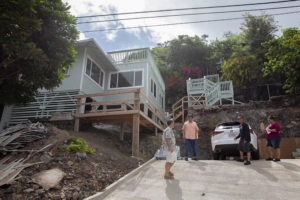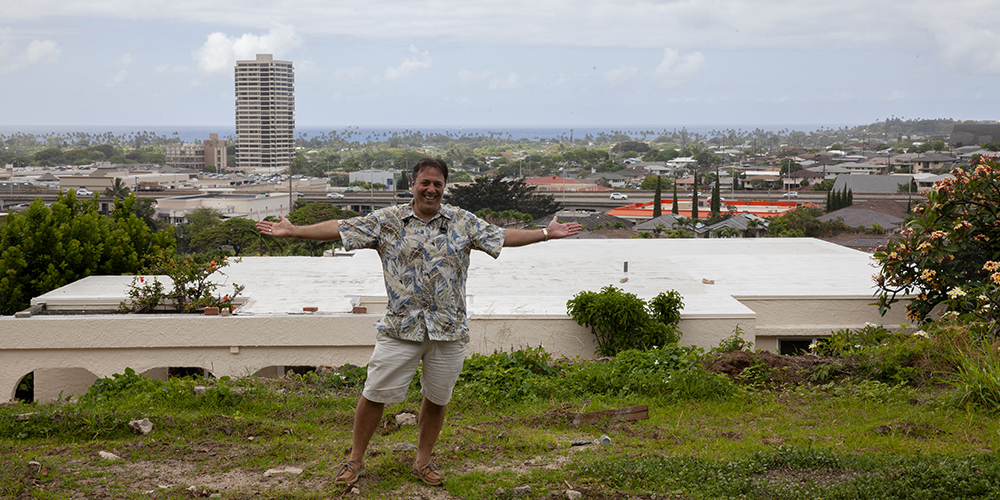Prologue
I looked out the large windows of the classroom on the 17th floor. I could see the massive Ala Moana Shopping Center right below us with the multi-million dollar Park Lane condominiums perched on top of it all. Just beyond that was Ala Moana Beach Park. I could see the surfers out on the water, taking turns catching waves. The sky was clear. Another perfect Hawaiian day.
“I could be out there right now.” I thought to myself.
But instead, I’m stuck in this freezing classroom all day with three strangers and a house flipping god.
I turned around to look at the room. My three classmates sat quietly, shuffling papers around and getting organized. Michael Mazella was sitting in the front of the class, typing away at an email on his laptop; probably in the process of closing another six-figure deal.
“Remember this scene.” I thought to myself again with a smile.
This is where I’ll get the education I need so that I can gain financial independence. So that one day, I can instead look back at this classroom from my surfboard, riding the waves on another perfect Hawaiian day.
Day One:

Day one with Michael Mazzella went well. As expected, he introduced himself, talked about his history in real estate, and where he’s at today. Throughout the day, we covered the usual “day one” topics you would expect to cover in any course. For this course, in particular, it was the basics of real estate investing.
If you’re like me and have been wanting to get into real estate for quite some time, then you’ve already taken the time to read various books and articles on how to get started in real estate investing. Things like “buy-and-hold” and “fix-and-flip” strategies, how to use creative financing to fund deals without using your own money, etc.
I don’t want to bore you with those details; you can find that information anywhere. But what I do want to talk about are those little nuggets of wisdom Michael had shared with the class that ranged from me simply nodding my head in agreement to me sitting there wide-eyed, jaw open after realizing the utter brilliance of his strategies.
Mindset Shift
During the morning, he spent a considerable amount of time talking about how our mindset needs to change. I honestly didn’t quite get exactly what he had to say. I feel like he has this greater understanding of life than I do, but even he couldn’t quite express or explain himself the way he wanted to. But here’s what I got:
In about 80 years, none of us will be alive. A 100 years after that, no one alive can say that they’ve met you. And by then, you would be forgotten. Think about it: When was the last time you thought about your grandparents that have passed? What about your great-grandparents?
In the grand scheme of life and the entire existence of human beings, our time here on earth is extremely limited. No matter how you live it, none of it will matter once you pass. So why fear failure? Just do it.
The wealthiest 1% at any period of our existence were successful because they had a different mindset. It wasn’t due to their IQ, their level of education, or because of their family’s wealth; they just thought differently from the rest. They thought critically in every situation, overcame whatever fear or mental block they had and found a solution that brought them success.
Michael said that in order for us to succeed after his mentorship is over is that we need to be:
- Educated
- A Trigger-puller.
He can give us all the education in the world, but it will all be useless if we don’t get out there, overcome our fear of failure, and pull the trigger. What’s also important is that we don’t blindly pull the trigger. That would be reckless. What’s important is that we learn as much as we can and become “educated trigger-pullers”. Which brings me to my next topic.
The Importance of Financial Education
We already know this, but I think it’s important to reiterate. People need to educate themselves on the different ways to become financially independent; that is, living a life without worrying about where the next paycheck will come from. Working a job to pay your expenses till you retire and then trying to live off your retirement funds till you pass is not the way to go.
Learn how you can make your money work for you through investing. For me, I want to learn how to fix and flip properties for big returns. Then take those returns and invest them into a more long-term passive income strategy like buy-and-hold.
But what made me want to reiterate this topic is the fact that no one can take away your financial education from you. You can lose all of your money, your belongings, etc., but no matter what, no one can take away what you already know.
Let’s give an extreme example:
If Trump lost everything he owned and was left with just the clothes on his back, what would he do?
He wouldn’t run to the state office and register a new company or spend time designing the perfect business card. He would use his real estate knowledge and look for his next deal, tap into his network to fund that deal, then execute. Which again, leads me to the next topic.
Two Most Important Things in Real Estate Investing
- Find a deal
- Fund a deal
Everything else is a distant third. Things like your business’ name or how cool your business cards look aren’t important right now. Quite frankly, you don’t really have a real estate business if you don’t even have a deal to fund.
Dumb Money vs Smart Money
The majority of people save their money in super low-interest rate (<1%) savings accounts with their banks. While having a liquid emergency savings fund is always a good idea, anything beyond six months of emergency funds is throwing money away. With today’s inflation rate of around 2%, people are losing more and more buying power over time. This is dumb money.
That same bank takes the money in people’s savings accounts and loans it out to individuals or businesses that need money for various things (e.g.: car loan, small business loan, etc.) at 5-10% interest! This is smart money.
Stop putting money in low-interest savings accounts, or into investment accounts with high fees! Invest your money in real estate, or put your money to use and loan to active real estate investors to earn 8-12% interest on your money passively.
Structuring your Business and Becoming “Uncollectable”
This section right here is where my mind was absolutely blown. If you know Michael, it is no secret that he puts all of his properties into their own LLC under his own corporation. Each LLC has its own bank account where money flows in and out of, and each LLC has records of all shareholder meetings and follows a strict corporate structure. This is to ensure that anyone that tries to sue Michael can only sue the LLC that the property is in. Following the strict corporate structure prevents the possibility of “piercing the corporate veil” where plaintiffs can go after the defendant’s personal property.
Now here’s the part that blew my mind: Every piece of property that you own, you have some equity. You can have a shell corporation in Nevada where you sign off the remaining equity towards, so when you get sued, there is literally nothing to take. The first position on the property’s lien is your primary lender, whether that be private money or a hard-money lender. The second position might be smaller private money lenders or even yourself. Whatever is remaining, write a third lien and assign it to your shell corporation.
Now when you get sued and the plaintiff’s lawyer looks into the LLC’s assets, they will see a house that is completely leveraged out. An honest lawyer will tell the plaintiff that even if he wins, the LLC is uncollectable. If the plaintiff wants to continue to sue and somehow wins, they will have to liquidate the assets (in this case, the house). At this point, the plaintiff is basically doing Michael’s job of selling the house for him. Once the house is sold, the first position lien holder gets paid, then the second, then the third (your own shell company). Nothing will be left for the plaintiff except his own legal fees due to his lawyer, which will have to come out of their own pocket.
Day Two:

Day two was filled with even more learning. The first half of the day was spent looking at three of his properties and driving for dollars.
His first property was massive. It originally had three houses on it, but he bulldozed the distressed property closest to the street and created a parking area for the future owner. This adds incredible value to the property considering that the roads in the neighborhood we were in were already narrow with people parking in the streets.
The other two homes were remodeled and each home had two floors. The first floor of each home had a wet bar and two bedrooms with a bathroom. The top floors of each unit have a full kitchen, as opposed to a wet bar, as well as 2-3 bedrooms and 2 baths. This floor would be where the actual homeowner would live. So future owners could live in the entire unit, or rent out the bottom units if they wanted to!
The property also had a small lot at the top of the hill that offered amazing views. Michael already has plans to build a third unit on that lot for additional profit!
But let’s back up a little and see the actual genius of this rehab project. Michael and his partner bought ONE property that had three units on it. One unit was so bad, he bulldozed it but still added value by converting the land the old house was on into a small parking lot. The second thing he did was set up the remaining two houses as potential income properties for the future owners. The future owners may want to use the entire space for their family or may attract a savvy homeowner/landlord to buy the home because of the potential rents they may receive to offset their mortgage. Lastly, he saw the potential use of the empty land available at the top of the hill.
Sure, it takes a long time to get the right construction permits and getting his CPR approved, but there is a huge payoff for him and his partner in the end. Over a million dollars each. No, that was not a typo.
The second property we visited was still in the middle stages of its rehab. This property also had three homes on it. With this property, he again removed the distressed home closest to the street and converted it into a driveway for the future owners; adding incredible value from the start.
The second home was also expanded to create a larger living area. What was great about this home is that he added a rooftop terrace. When we went up to the terrace, we all said, “wow”; and that was exactly what he was going for. Michael went on to explain that creating this terrace was not only cheap, but it adds incredible value to the home. You could entertain guests or just have relax outside on top of your roof overlooking the valley.
However, the rehab has been delayed thanks to a nosey neighbor who called the health inspector with concerns over asbestos inside the demolished home, and a few other state agencies to delay the rehab as much as possible. All-in-all, that single neighbor has already cost this rehab a whopping $20,000! But if you take Michael’s mentorship program, he will teach you how to mitigate these kinds of unexpected costs and still come out on top.
The third home on this property was nicknamed the “Eagle’s Nest” due to its high position on the side of the mountain. Although the walk up the staircase to the third house is long, the views it offered was amazing. However, this house has also been delayed thanks to inspectors dragging their feet to come inspect the plumbing and electrical wiring before the drywall can go up.
The last property we visited was a condo rehab that has recently gone into escrow. The property is in a luxury high-rise condo right next to Ala Moana Beach Park and right across the street from Ala Moana Shopping Center. The property was beautifully rehabbed, but the rehab also took a long time due to permitting delays. The construction could have been done in a matter of weeks, but because of the process of getting a permit accepted took months, it cost Michael thousands of dollars in holding costs. He will still profit from this property, but not as big as the first or second properties we visited.
Driving for Dollars

In between these property visits, we spent some time driving for dollars (DD). It was personally my first time doing so, but we found 20+ properties in a matter of 15 minutes. I don’t know if that’s normal, or if we were in a “target-rich environment” that had plenty of distressed or ugly properties in between beautiful homes with prideful owners.
The reason I bring this up is because Day Two’s homework involves an hour of DD and also sending out letters to these owners by looking up their names on Honolulu’s Tax Records website. The goal is to send out 20 letters per week. If I spent an hour DDing around my local area and had the same results, I could technically drive for one hour and have enough letters to send out to reach my weekly quota for an entire month! Which got me thinking, what if I spent three hours a week DDing? I increase the number of letters I send out, thus increasing my chances of finding someone interested in selling their home.
In addition to these 20 letters, I also have to send out 20 Letter of Intents (LOI) per week; a non-binding offer on properties already on the MLS. The beauty of these LOIs is that I can fire them off to many potential properties/realtors in a matter of a few hours. 20 LOI’s per week? That can be done in two to three hours tops.
Increasing Responses to Letters
After we returned to the classroom, we started talking about increasing our response rates to letters. Long story short: female name/voice/handwriting has a higher chance of receiving a response than that of a male. It’s also important to differentiate yourself from others by doing things like adding a dollar to each letter or handwriting your letter. Have a compelling message. Most responses are received after the fourth contact.
Focus on Business
An important point Michael brought up is that, as a house flipper, we may be tempted to paint the walls or lay some tile ourselves in order to save some money on rehab costs. This is not what we need to be focusing on. As a house flipper, we need to run the business as a whole. Orchestrate each project as a business manager, and just make sure that your contractors have everything they need in order to get the job done. Chances are they can get the job done much faster and at a higher quality than you could yourself.
“The mind, once stretched by a new idea, never returns to its original dimensions.” – Ralph Waldo Emerson
An Exercise on Perspective
Michael had asked us to observe a water bottle he had placed on a chair. He described what he observed and asked us to compare what he said to what we saw. Did we see the exact same things? No. He was standing at a different angle everyone else and had a different perspective. Even the classmates to my left and right had different perspectives on the same object: the water bottle.
So why did Michael have us do this exercise? It goes back to the whole mindset change. We all see the same object differently. Have an open mind, go against the grain, and see what the 1% sees when they look at the same object.
It was a simple exercise, but it was an important one. Why? Because he went on to destroy my own understanding of “sound financial advice”. What he sees is completely different from what I see. It will challenge your own views on money management. Whether or not you choose to accept this information is completely up to you. However, to me, it all makes sense.
Equity
The 99%: Equity is good. Owning your home free and clear is the goal. No more mortgage means more money to put into a separate savings account for vacations, a new car, etc. or even put away into your retirement account.
The 1%: Equity is useless. Equity is just money that’s sitting doing nothing.
Pull your equity out via HELOC and invest it into something that will make a return. Like what you ask? Jump on the side of smart money and become the bank. Become a private money lender at 10-12%! When was the last time your investment portfolio/401k/IRA earned 10%?
Pulling out your equity also doubles up as asset protection. If you get sued, guess what, there’s already a lien on your property so now you’re “uncollectable”.
Michael’s course dives deep into the way the 1% thinks that allows them to grow their wealth faster than the rest. The 1% mindset is logical and pulls you away from the traditional “work, and save for retirement” way of life.
On Private Money Lenders
When you’re looking to fund your real estate deals through private money, you’re not asking for money, you’re offering an opportunity to earn greater returns on their investments. If they’re used to investing in the more traditional mutual fund or index fund (~8% returns), or even just dumping money into their retirement account (<5% returns), you are offering them a better investment vehicle to grow their wealth.
You are offering 10-12% returns with real estate backed collateral to lenders, unlike stock/commodities trading. Meaning if your house rehab fails for whatever reason, your lenders can recoup most, if not all, of their investment by selling the property. On the stock market, once your portfolio sinks, the only thing you can do is wait for the market to bounce back, or sell your shares at a loss.
Treat your investors right no matter the cost. The second you leave them hanging is when you lose all trust and credibility.
Michael takes care of all of his investors regardless of how bad a rehab project goes. In the rare event that he loses money on a project, Michael has so many other profitable projects going on that he can still pay all of his investors the full amount of interest and principal owed.
Michael is king when it comes to trust and credibility. As a matter of fact, my classmates and I witnessed first hand an email coming in from an individual asking if he can invest $1million in Michael’s business!

This is where I’ll end my narrative.
“But wait!” You exclaim. “Isn’t the course four days? You only talked about day one and two!”
Yes, it is! I could write about everything I learned with Michael (which I actually do plan on doing on this blog), but the best way to get started in house flipping is to sign up for his mentorship program and learn from the master himself.
While the education itself is valuable, I believe meeting him and developing a mentor/mentee relationship is invaluable. Nothing will replace the in-person relationship that I built through my time on his course. He now has my phone number on his phone, so whenever I call/text or email with a question, he knows it’s me and will respond in a timely manner.
In addition to having him as your mentor, you will also gain access to his network. He has spent years of his own time and money vetting contractors, realtors, hard money lenders, etc.
In all honesty, the education you need to get started is already available online for free, but you won’t get Hawaii-specific advice, or get access to Michael himself and his network unless you take his course. You may gawk at the price, but in the grand scheme of things, the price is pretty low. You could make that up in a single wholesale deal or many times that in a single house flip!
If you’ve been on the fence about signing up for his mentorship program, and this article finally convinced you to take the leap, let Michael know I sent ya.
If you’re interested in reading more articles I publish, sign up for my newsletter and be notified whenever I publish anything new!
